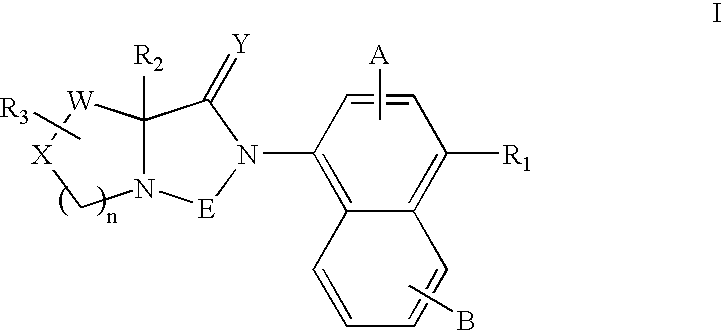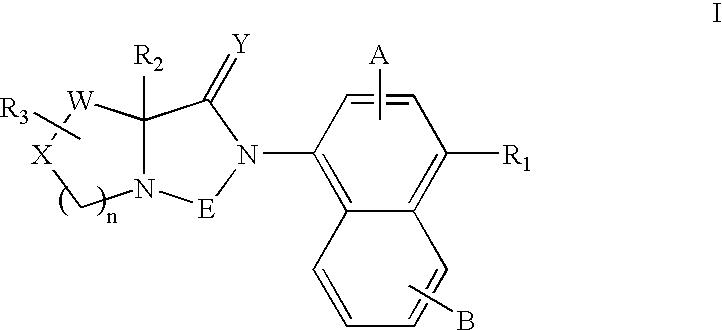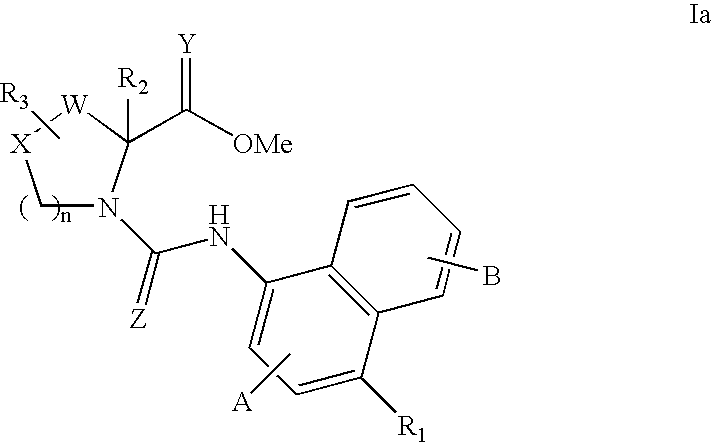Bicyclic modulators of androgen receptor function
- Summary
- Abstract
- Description
- Claims
- Application Information
AI Technical Summary
Benefits of technology
Problems solved by technology
Method used
Image
Examples
example 1
Tetrahydro-2-(4-nitro-1-naphthalenyl)imidazo[1,5-α]pyridine-1,3(2H,5H)-dione
[0211]
1A. 4-Nitro-1-naphthaleneisocyanate
[0212]
[0213]To a yellow solution of 1-amino-4-nitronaphthalene (5.17 g, 27.5 mmol) in CH2Cl2 (80 mL) was added solid NaHCO3 (23.10 g, 275 mmol). The resulting suspension was stirred at 0° C. for 15 min, then phosgene (20%) in toluene (110 mmol) was added rapidly to the suspension. After addition, the mixture was stirred at RT for 2 hours, then filtered to remove the solid. The filtrate was concentrated under reduced pressure, the resulting solid residue dried in vacuo for 1 hour to give approximately 6.0 g of the title compound as a brown solid.
1B. Tetrahydro-2-(4-nitro-1-naphthalenyl)imidazo[1,5-α]pyridine-1,3(2H,5H)-dione
[0214]To a solution of ethyl pipecolinate (0.234 g, 1.49 mmol) and compound 1A (0.29 g, 1.355 mmol) in toluene (6 mL) was added 4 Å molecular sieves (1.0 g). The mixture was stirred at room temperature overnight, filtered. The filtrate was diluted w...
example 2
Tetrahydro-2-(4-nitro-1-naphthalenyl)-1H-pyrrolo[1,2-c]imidazole-1,3(2H)-dione
[0215]
2A. (2S)-1-[[(4-nitro-1-naphthalenyl)amino]carbonyl]-2-pyrrolidinecarboxylic acid methyl ester
[0216]
[0217]To a solution of L-proline methyl ester hydrochloride (257 mg, 1.43 mmol) in MeOH was added triethylamine (0.2 mL, 1.43 mmol). The solution was concentrated under reduced pressure to give a white solid residue, which was triturated with ether (3×). The collected ether solution was concentrated under reduced pressure to give L-proline methyl ester free amine (220 mg) as a colorless oil. To a solution of above free amine in toluene (5 mL) was added compound 1A (278 mg, 1.3 mmol), followed by 4 Å molecular sieves (1.0 g). The mixture was stirred at room temperature overnight and filtered. The filtrate was diluted with EtOAc, washed with 1 N aqueous HCl, water, brine, dried over MgSO4, concentrated under reduced pressure to give a crude product, which was chromatographed (silica gel) eluting with CH2...
example 3
(6S)-Tetrahydro-6-hydroxy-2-(4-nitro-1-naphthalenyl)-1H-pyrrolo [1,2c]imidazole-1,3(2H)-dione
[0219]
[0220]cis-4-Hydroxy-L-proline methyl ester hydrochloride salt (107 mg, 0.59 mmol) in MeOH was treated with triethylamine (82 μL). The solution was concentrated under reduced pressure and the resulting residue triturated with ether (3×50 mL). The combined ether extracts were concentrated under reduced pressure to give the amino acid ester as a free amine, which was suspended in toluene (10 mL) and compound 1A (126 mg, 0.59 mmol) was added, followed by 4 Å molecular sieves (˜1.0 g). The mixture was stirred at RT until compound 1A was consumed (˜2 hours). DBU (90 μL, 0.59 mmol) was added, the resulting dark-red colored suspension was heated at 67 C.° for 2 hours. The reaction mixture was cooled to RT and filtered. The filtrate was diluted with EtOAc, washed with saturated aqueous NH4Cl, water, brine, dried over MgSO4 and concentrated under reduced pressure to give a crude product, which w...
PUM
| Property | Measurement | Unit |
|---|---|---|
| Composition | aaaaa | aaaaa |
Abstract
Description
Claims
Application Information
 Login to View More
Login to View More - Generate Ideas
- Intellectual Property
- Life Sciences
- Materials
- Tech Scout
- Unparalleled Data Quality
- Higher Quality Content
- 60% Fewer Hallucinations
Browse by: Latest US Patents, China's latest patents, Technical Efficacy Thesaurus, Application Domain, Technology Topic, Popular Technical Reports.
© 2025 PatSnap. All rights reserved.Legal|Privacy policy|Modern Slavery Act Transparency Statement|Sitemap|About US| Contact US: help@patsnap.com



